
1. Control plasticizing temperature
Because the decomposition temperature of the crosslinking agent and the foaming agent is hindered, the degree of crosslinking is low, the viscoelasticity required for foaming is not achieved, the decomposition of the foaming agent is incomplete, and supersaturated gas is not generated inside the melt. Unsatisfactory foamed products are not obtained. The temperature is too high, on the one hand, the crosslinking agent and the foaming agent are decomposed too fast, the melt is not too loose, and the foaming is extremely unstable; on the other hand, the melt viscosity is too low, the surface tension is small, and the cells are broken or fused. . Therefore, in the molding process, the plasticizing temperature should be properly controlled to obtain a better foamed product.
2. Reasonable cooling rate
During the curing phase, a reasonable cooling rate has an important effect on the density and performance of the final product. Therefore, processing equipment (including extruder type, screw configuration, pressure control device, foaming machine head), if physical foaming agent is used, its injection and metering as well as process parameters (including temperature and pressure, etc.) for final foaming The foam structure, density, mechanical properties and thermal properties of the material will have a major impact.
3, the appropriate head temperature
The foaming system is subjected to rapid nucleation and growth through the forming head. In this process, it is necessary to induce a larger supersaturation pressure and a faster supersaturation pressure drop to form a large number of bubble nuclei at the same time. During the growth process, proper head temperature is critical to the stability of the growth bubble and the control of the final product expansion rate.
4, improve injection pressure
Because: (1) Under high injection pressure, the bubble is generated only after the melt flows through the flow path and the stress established in the melt begins to be released in the mold cavity.
(2) Increasing the injection pressure can shorten the filling time, which means that the bubbles do not have a long time for growth during filling.
(3) The higher the injection pressure, the more energy is stored in the melt, and the longer it takes for the stress to relax, so that the bubble can only grow after a period of time. At low injection pressures, the air in the cavity has enough time to escape out of the cavity; at high injection pressures, due to the inability of the air to escape, an additional pressure is created in the melt, delaying the bubble. Formation and growth. For a number of reasons, to get the ideal product, the injection pressure should be increased, that is, the injection speed should be increased. The ideal injection time is 1 to 3 s.
5, foam type selection
Most of the EVa foaming is chemical foaming, and the foaming agent used is azodicarbonamide or diisopropyl azodicarboxylate. Of course, nitrogen can also be used as a physical foaming agent for physical foaming. In addition, the physical foaming method of directly injecting gas is also applied in the extrusion molding process of EVA foam. The process parameters affecting the extrusion foaming mainly include: extrusion pressure, extrusion temperature, residence time of the material in the extruder, axial pressure of the die, and the like. In general, as the extrusion pressure is higher, the cell size is smaller, and the number of cells is larger, and a high-quality foam is only available in a narrow temperature range. The higher the melt temperature, the lower the polymer melt strength, and the foaming pressure within the bubble is likely to exceed the surface tension of the foam causing the foam to rupture. Therefore, the production must be optimized according to the specific polymer system to determine a suitable foaming temperature, thereby prolonging the residence time of the material in the extruder and increasing the number of bubbles.
6, control the crystallization temperature
In EVA extrusion foaming, the foam structure is affected by melt crystallization and solidifies at the extruder head. Therefore, the crystallization temperature of the EVA at the extruder head is very important. If the crystallization occurs early in the foaming (that is, when the dissolved blowing agent just diffuses out of the melt and enters the nucleated bubbles), the earlier curing occurs. The amount of gas that will cause the bubble to grow is insufficient, resulting in insufficient power for bubble growth, which will affect the expansion ratio and the density of the final product; if the rate of crystallization is too fast, this will also occur. However, if the head temperature is kept high and the crystallization time is long, the probability of gas diffusion and escape increases. Therefore, suitable crystallization temperature and crystallization rate have an important influence on the extrusion foaming of EVA.
1. Use Surface Mount System to install electron component. High quality stable and more quality consistency.
2. Pass germany TUV testing, have EMC and LVD certificate.
3. The AC input power voltage is made between 85V to 240V. So it could select AC input voltage automatically. You could work in AC USA 110V or AC europe 220-240V.
4. CEL: Cellulose electrode is special electrode to lay big pipe on oil and chemical industry, natural gas, electric power, civil pipeline of oil, gas, water. They need high ilder voltage (more than 90V). This machine could do
Tig Mig Welder, Mig Tig Welder, Types Of Welders, Tig or Mig Welder
YongKang WALMA Tools CO., LTD. , http://www.walmatools.com
